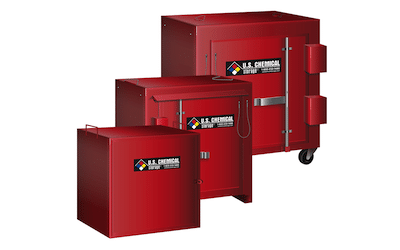A catastrophic explosion rocked the island country of Cyprus in 2011. Approximately 100 containers holding explosives ignited. The results were devastating – 12 people lost their lives. It also took out a local power station and injured another 60 people. As this incident demonstrates, improper storage of ammunition and explosives can be detrimental.
What is an Explosive Storage Magazine?
Explosive storage magazines provide safe storage of ammunition and explosives. These storage magazines protect the contents from risks such as:
- Fire or sparks that could ignite the contents
- Bad weather that could expose the contents to the elements, rendering them useless
- Theft that could place dangerous weapons in the hands of either harmful people who may purposely hurt others, or incompetent people who will put themselves and others at risk
Regulations for Explosive Storage Magazines
The Bureau of Alcohol, Tobacco, Firearms and Explosives (ATF) set the requirements for explosive and ammunition storage in
ATF 27 CFR, Part 555. This standard defines types of storage magazines based on the explosive classes:
| Magazine |
Type of Permissible Explosive |
| Type 1 |
All classes |
| Type 2 |
All classes |
| Type 3 |
Temporary attended storage of all classes |
| Type 4 |
Low explosives, blasting agents and non-mass detonating devices |
| Type 5 |
Blasting agents |
General features specified by the ATF standard include these
safety requirements:
- Closing magazine doors should make their hinges inaccessible. Secure hinges by welding, riveting or bolting with the nuts on the inside of the door.
- Protect locks with ¼-inch steel hoods to prevent sawing. Each door must include two mortise locks, two padlocks (with five tumblers or casehardened shackles) or a combination of both. Three-point locks are also acceptable.
- Lighting must meet NEC or NFPA 70-81 to prevent sparks inside the magazine.
- Cover interior walls with non-sparking material.
- Metal edges and doors must overlap sides by at least 1 inch.
- Wall construction varies according to the type of storage and the material of construction. Details are available in the standard itself.
SEE ALSO: ATF Explosives Magazine Construction Requirements
U.S. Chemical Storage Provides Explosive Storage Magazines
U.S. Chemical Storage manufactures and supplies magazines for explosive and ammunition storage. All magazines meet ATF 27 CFR, Part 555.208 and DoD 5100.
Four model ranges are available:
Type 2 outdoor explosive magazines for high explosives
Type 2 indoor explosive magazines for high explosives
Type 3 day boxes for transfer and temporary storage of explosives
Type 4 indoor/outdoor explosive magazines for low explosives
Industrial Applications for Explosive Storage Magazines
Mining and quarrying are major industry users of explosives. Their need for regular receipt, storage and use of explosives requires strict safety protocols to prevent catastrophic incidents and injuries.
The military is a large-scale user of ammunitions and explosives. Military bases must take care to preserve safe distances between explosive storage magazines. Standards dictate safe distances based on the type of explosives involved and the type of construction of the magazines.
RELATED ARTICLE: Military Preparedness – 4 Tips for Safe Fuel and Oil Storage
Construction and demolition sites also use explosives regularly. Always use the correct type of explosive magazines to satisfy the local authorities.
Contact U.S. Chemical Storage for Explosive Storage Solutions
U.S. Chemical Storage manufactures and supplies ammunition and explosive storage magazines. We meet ATF codes to provide peace of mind about the safety of your stocks. Find out more about our standard models
here or
contact us for a custom explosive storage magazine for your needs.
References

